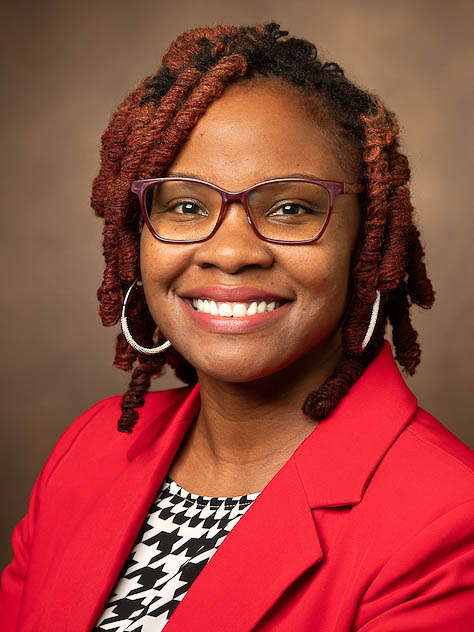Faculty Practice Spotlight
Faculty practice provides faculty members with the opportunity to be engaged in their area of expertise. As leaders of exemplary, innovative, and culturally proficient faculty engagement, faculty members fulfill the mission of the UA Capstone College of Nursing’s Faculty Practice Committee. The Faculty Practice Committee strives to increase the visibility of the school of nursing by spotlighting the practice of faculty members as they practice in community agencies. Practice sites are diverse and represent the expertise and background preparation of faculty engaged in faculty practice. Faculty “spotlights” are updated multiple times annually to showcase the exceptional work of faculty practice members. Be sure to return to this webpage in the future to learn about the practice of other faculty members!

Shameka L. Cody, PhD, AGNP-C, PMHNP-BC
Associate Professor
My role at the CCN is a tenured associate professor with a research focus on sleep and comorbid disorders in older adults with HIV. I am an instructor and course leader for the RN-BSN Nursing Informatics course and the PhD Grant Writing course. I serve as the co-chair for the Behavioral and Prevention Research Core, an interprofessional collaborative group that promotes innovative research and community engagement to improve health outcomes for vulnerable populations. In addition, I mentor undergraduate students, graduate students, and junior faculty who are interested in building programs of research that involve community-driven interventions and multisector partnerships.
I have been a board-certified adult and geriatric nurse practitioner since 2011. Currently, I work in an outpatient clinic as a contract nurse practitioner for the social security administration where I evaluate disability claimants.
The social security administration serves patients of varied race, age, ethnicity, gender, sexual orientation, gender identity, language, and geographical location. Majority of our claimants are age 50 and older, have more than one chronic health condition, live in underserved areas, and are uninsured or underinsured.
My practice days are on the weekends with an average patient load of 22-25 claimants per day. Claimants are scheduled in 30-minute slots. Claimants may file for disability based on a physical ailment, psychological condition, or both. During the appointment, I gather information about the claimant’s medical history and perform a comprehensive physical exam to assess their physical strengths and limitations. I assess the claimant’s physical health, mental health, social health, and functional health as it relates to their disability claim. Unfortunately, for many claimants without health insurance, their health conditions require emergency care when they arrive for their appointment. I refer these claimants to the nearest ER for further evaluation.
People with disabilities represent an increasingly recognized target population whose healthcare needs should be addressed. Several models are used to examine health outcomes for people with disabilities. In the clinical setting, I examine impairments related to the disability including the activity restrictions, functional limitations, independent living, economic hardships, and lifestyle and behaviors. In addition, I administer part of the Short Form-36 survey to assess claimants’ quality of life, specifically inquiring how much their physical condition interfere with their ability to perform everyday activities. Also, I contact the social security case worker if the claimant’s physical condition has contributed to poor psychological outcomes.
I am interested in interdisciplinary collaboration to develop sleep interventions and integrate services for vulnerable groups who are stigmatized and/or lack access to healthcare. For residents of Alabama who are unable to afford a clinic visit or transportation to see their providers, we need interdisciplinary teams in the communities providing care and preventing further delays in diagnoses and treatment. My professional interests also include integration of sleep interventions and behavioral health services for vulnerable groups (e.g., older adults, people with HIV, people with substance use disorders, etc.), and evaluating the long-term impact of chronic health conditions on mental health.
My clinical experiences continue to fuel my passion for translational research. In 2023, I expanded by clinical expertise and became a board-certified psychiatric mental health nurse practitioner. I will facilitate partnerships between academic and healthcare professionals to address the physical and psychological needs of vulnerable populations. My research is highly interdisciplinary and community-focused which helps with identifying barriers to healthcare access among vulnerable groups. Academic research teams should strive to understand these barriers, develop innovative interventions to address the barriers, and evaluate implementation of interventions in the clinical setting and to the community at large. Most importantly, our research teams must include individuals who are directly impacted by disease to ensure interventions are accessible and yield the best health outcomes for everyone. I look forward to inviting individuals from the community and clinical setting to the research table to work with our teams on sleep and cognitive interventions from conceptualization through dissemination.
Poor sleep is a driver for many chronic diseases and has been linked to poor cognitive outcomes. Some older adults with poor sleep manifest cognitive impairments and other do not. There is variation in pharmacological and nonpharmacological treatment response for sleep disturbances among older adults. Many of these differences may be associated with social determinants of health including lifespan environmental exposures that warrant further investigation.
My program of research includes collaborations with researchers across disciplines, academic institutions, and community sectors to improve sleep quality and address comorbid disorders in older adults with HIV. Innovative solutions to address the diverse needs of people with HIV and older adults necessitate interdisciplinary, diverse academic and clinical research teams. My role as an advanced practice nurse and PhD-prepared nurse scientist at the CCN has positioned me to help bridge the gap between research and clinical practice as well as build and sustain partnerships to improve the health of Alabama residents.